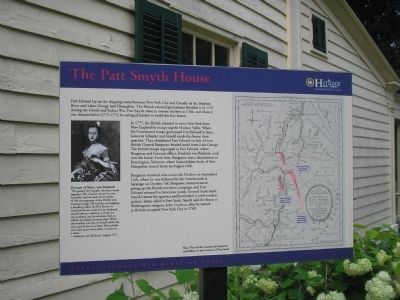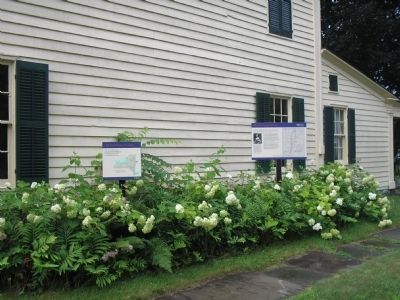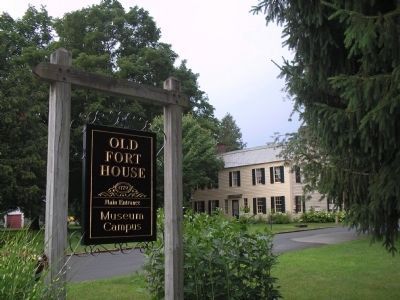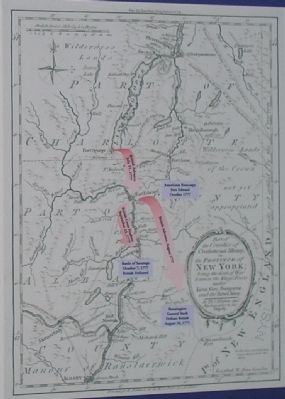Fort Edward in Washington County, New York — The American Northeast (Mid-Atlantic)
The Patt Smyth House
Fort Edward lay on the shipping route between New York City and Canada via the Hudson River and Lakes George and Champlain. The British colonial government fortified it in 1755 during the French and Indian War. Patt Smyth came to oversee the fort in 1764, and when it was dismantled in 1772-1773, he salvaged lumber to build this fine house.
In 1777, the British planned to sever New York from New England by occupying the Hudson Valley. When the Continental troops garrisoned Fort Edward in June, Generals Schuyler and Arnold made this house their quarters. They abandoned Fort Edward on July 31st as British General Burgoyne headed south from Lake George. The British troops regrouped at Fort Edward, where Burgoyne and German officer, Friedrich von Riedesel, tool over the house. From here, Burgoyne sent a detachment to Bennington, Vermont, where General John Stark of New Hampshire routed them on August 16th.
Burgoyne ventured west across the Hudson on September 13th, where he was defeated by the Continentals at Saratoga on October 7th. Burgoyne retreated north, giving up the British northern campaign, and Fort Edward returned to American hands. General Stark made Smyth’s house his quarters and barricaded it with wooden pickets. Some called it Fort Stark. Smyth sold the house to Washington’s surgeon, John Cochran, after he moved to British-occupied New York City in 1780.
Revolutionary War Heritage Trail
Erected by State of New York.
Topics. This historical marker is listed in these topic lists: Notable Buildings • War, French and Indian • War, US Revolutionary. A significant historical month for this entry is July 1802.
Location. 43° 15.699′ N, 73° 34.823′ W. Marker is in Fort Edward, New York, in Washington County. Marker is on Broadway, on the right when traveling south. Marker is located on the north side of the Smyth House. Touch for map. Marker is at or near this postal address: 29 Broadway, Fort Edward NY 12828, United States of America. Touch for directions.
Other nearby markers. At least 8 other markers are within walking distance of this marker. Old Fort House Museum (here, next to this marker); Smyth House (a few steps from this marker); Gen. Washington (about 400 feet away, measured in a direct line); Old Moat (approx. ¼ mile away); Old Fort Edward (approx. ¼ mile away); Fort Edward (approx. ¼ mile away); Northeast Bastion (approx. ¼ mile away); The Island (approx. ¼ mile away). Touch for a list and map of all markers in Fort Edward.
More about this marker. The right of the marker contains a map of “Part of the Counties of Charlotte and Albany in the Province of New York.”
The left of the marker features a “Portrait of Mme. Von Riedesel" with the
quote
“We passed very happily the three weeks together. The country around us was beautiful, and we were in the midst of the encampment of the British and German troops. We had for our lodgings a dwelling called the Red House. It consisted of one room for my husband, myself and our children, a study for my husband, and an entrance hall, in which my female servants slept. When the weather was fine we dined under the trees, and if not, in a barn. Here planks were laid upon some casks, to serve as a table.”
- Madame von Riedesel, August 1777
Also see . . . Old Fort House Museum. Museum website homepage (Submitted on September 25, 2008, by Bill Coughlin of Woodland Park, New Jersey.)
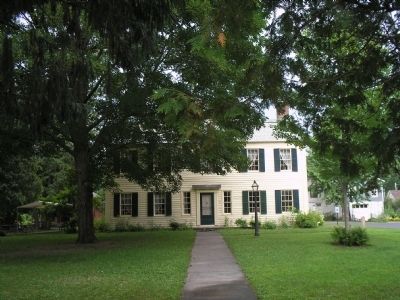
Photographed By Bill Coughlin, July 13, 2008
3. The Patt Smyth House
The Patt Smyth House was constructed by Patrick Smyth in 1772 with timbers taken from the ruins of Fort Edward, a French and Indian War fortification. Smyth was arrested at the house in 1777 by General Benedict Arnold for being a loyalist to the British Crown. During the Revolutionary War, the house was used by both British and American troops as headquarters.
Credits. This page was last revised on August 20, 2021. It was originally submitted on September 25, 2008, by Bill Coughlin of Woodland Park, New Jersey. This page has been viewed 1,256 times since then and 14 times this year. Photos: 1, 2, 3, 4, 5. submitted on September 25, 2008, by Bill Coughlin of Woodland Park, New Jersey.
